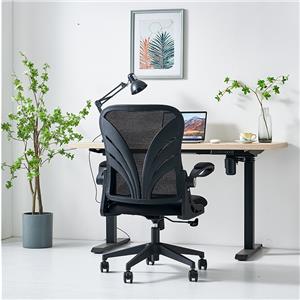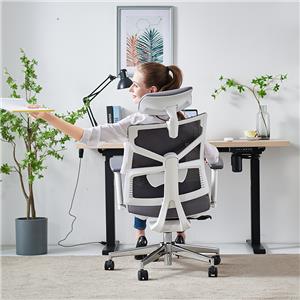Why can’t you buy a comfortable ergonomic chair?
1. Why study ergonomic chairs?
Elderly people who have to work in front of a computer for 8 to 24 hours a day are more likely to suffer from lumbar muscle strain and tenosynovitis. From studying how to massage to studying sports rehabilitation, teach yourself sports anatomy. I finally understood that in addition to computers, tables and chairs are also production tools, and choosing the right ones can reduce "work injuries." Given my knowledge of sports rehabilitation and sports anatomy, I think I still understand ergonomics.
2. What exactly is ergonomics?
We have heard of ergonomic mice, ergonomic chairs, and ergonomic mattresses, but what exactly is ergonomics? Ergonomics means that the size of items matches the body size and weight of the person. The sizes of items for tall, short, fat and thin people are different to ensure that the human body is in the posture that is least likely to cause strain. So what kind of sitting posture is considered suitable, so that the human body is in the posture that is least likely to cause strain? The sports rehabilitation specialist’s point of view is three 90°. In a sitting position, when viewed from the side: the center of gravity of the body is on the ischium (note the ischium), and when the waist has a certain lumbar curvature, the body is basically perpendicular to the ground and in line with the thighs. The included angle is 90° (that is, the hip joint), the thigh and the calf are at a 90° angle (knee joint), and when the palm of the hand is typing on the keyboard, the upper arm and forearm are also at a 90° angle (elbow joint). The computer screen should be directly in front of the head in a neutral position. I won’t go into details as to why this is the best posture. This belongs to the content of sports mechanics and anatomy. To achieve this goal, the size of the office chair and desk must match the size of the user.
3. What parameters should you pay attention to first when choosing ergonomic desks and chairs?
In order to achieve the three 90° goals, the first thing to pay attention to is the scale of the item! scale! scale! And not just chairs, tables and computer stands must be considered. At this time, don’t think about the shape of the lumbar support, the shape of the backrest, or the material of the seat! Because the overall scale is inappropriate, everything else is zero.
The size of the chair determines the two "90°" mentioned above for the lower body. The parameters involved are seat height and seat depth.
A. Seat height
It is the vertical distance between the seat surface of the chair and the ground, which is the height of the chair in the picture above. Obviously, calf length determines seat height. For people with longer calves, the distance between the chair surface and the ground must be higher to keep the knee joint at 90°; if the chair surface is too low, the knee joint angle will be less than 90°, just like sitting on a small bench; if it is too high, the knee joint angle will be less than 90°. The foot may be hanging, unable to use the ground to provide support, and the pressure on the back of the thigh will increase.
Some people may say that the height of the ergonomic chair can be adjusted? Yes, but what is the adjustment range? The seat surface is usually adjusted through an air rod, and the range is generally 8 to 10 centimeters. Open Taobao and do a random search. The chair height is usually 43 to 53 centimeters, and some brands even design it to an incredible 49 to 59 centimeters. Why this height? What height is it suitable for?
We can look at the four-legged dining chairs that cannot be adjusted. The standard dining chairs on the market for adults have a seat height of 45 cm (matching the dining table of 75 cm), which is the same as the European and American standards. The Japanese standard is 3 cm lower than the European and American standards at 42 cm. (The dining table is also low accordingly). This difference is because the scale of the furniture matches the human body size. The above standards are based on the average height of the country's citizens. If the average figure of the country is different, the size of the furniture will also be different. The average height of Japanese adult men is about 170cm, so the European and American standards are not directly used, but are somewhat lower than those in Europe and America. So what height is suitable for people with a sitting height of 45 cm in Europe and the United States - about 175 cm tall. They sat on a 45cm high chair, with their calves and thighs reaching 90° when their soles and heels were all on the ground. Of course, the same height has different body proportions. For example, Asians may have shorter legs than Europeans and Americans of the same height, and there may be differences in height. You don’t sit on the dining chair for a long time, so it may not have much impact if it is taller or shorter, as long as it is designed according to the average height.
Let’s go back and look at the office chair. Is the 43-53 cm seat height mentioned earlier really suitable for you? Are those IKEA office chairs with a lower seat height adjustment limit of 46 cm or even 52 cm really suitable for you? With such a height, could it be designed by IKEA based on Nordic standards?
Have you measured the seat height that suits you?
I have measured the height and seat height of the case: adult male A175 cm, the seat height is about 43-45 cm; adult female B157 cm, without wearing high heels, 38-40 cm; child A140 cm, seat height 36-39 cm is suitable; adult male B170 cm, 40-42 cm. In other words, the adjustment range of most ergonomic chairs on the market is 43-52 cm, which cannot be suitable for adult men under about 170 cm (probably about 50% of men), and girls may be 165 cm (women of the same height have longer legs).
So, why can’t you buy a comfortable ergonomic chair?
B. Sit deep
The 48cm in the red circle in the picture below is the sitting depth. Obviously, thigh length determines sitting depth. People with shorter thighs need less sitting depth. If the sitting depth is too large, either the lower back cannot reach the back of the chair when the upper body is perpendicular to the ground, or the popliteal fossa is pressed against the chair surface. The appropriate sitting depth is such that when the center of gravity of the body is on the ischium, the back of the chair can be leaned on, and the distance between the popliteal fossa and the sitting surface is no more than one punch, or at least the popliteal fossa cannot be pressed against.
Cases around me: Adult male A is 175 cm tall, sitting depth is 47-50 cm; adult female B is 157 cm tall, sitting depth is 40-43 cm; child is 140 cm, sitting depth is 36-40 cm; adult male B is 170 cm, sitting depth Depth 43-46 cm.
If the sitting depth is too small, the support on the back of the thighs will be reduced and the pressure on the buttocks will increase. The extreme case is sitting on a railing or a bench. There are many obvious cases in children's chairs where the sitting depth is too deep. Adult chairs often compensate by leaning back and tilting the pelvis backward, which is not easy to see in the picture. But if you really buy a chair that is too deep, you will either feel that your back is not supported and you need to add something (such as a lumbar support), or you will form a sitting posture with the pelvis tilted backward, and the center of gravity is not on the ischium, but on the lumbosacral region.
For an ergonomic chair that suits you, these two dimensions must be met. It's not that the lumbar support and head support are unimportant, but they are nothing if the two sizes are inappropriate.
C. 90° of upper limbs
It mainly depends on the height of the operating surface of the desk, usually the height of the keyboard. A common mistake is to pair a high table with a short chair. The angle will be greater than 90°, which is carried by the shoulders.
I measured it myself: adult male A175 cm, chair surface height 45 cm, desktop height 75 cm, keyboard tray under the desktop, 68-70 cm; adult female A157 cm, chair surface height 39 cm, keyboard height 65-66 centimeter.
If you are under 170cm tall, sitting on a chair with a height of 46cm, there is no keyboard tray on the desk, and the keyboard is placed on the table with the height of the keyboard reaching 78cm, it can be said that 8 hours a day is a punishment, and it may be more than 8 hours.
If you are only 160cm tall, then you need not only a small chair, but also a shorter table. Of course, you can also buy a normal desk and chair, sit high up, add a footrest under your feet, and a lumbar support for your back.
D. Some other questions
1. Why are the chairs and seating depth on the market so large?
Reasons for my personal speculation: a. Because the large-sized chair is for small people, and the foot pads and back pads can be used to adapt to small people, but not vice versa; b. The manufacturer follows the size standards of other countries and does not consider the average height or their goals. The group is an urban crowd and is inherently taller; c. In order to adapt to the height of the table, it caters to most customers who do not have a lift table.
2. Is an ergonomic chair an IQ tax?
no. But for different people, ergonomic chairs are not necessarily more comfortable than ordinary four-legged or bow-shaped chairs. In fact, office chairs with four legs or bows without wheels are more stable. If a non-adjustable chair happens to fit your body, it's likely that the chair will be more comfortable than a so-called ergonomic chair! I think this is also the reason why many people say that ergonomic chairs are IQ tax. They just bought a cheap chair with a size that matches their own. Of course, they don’t need those expensive ones that can be adjusted.
The greatest value of an ergonomic chair is its adjustability. One chair can suit different groups of people. In comparison, it should be the pursuit of extreme value - customizing the chair according to the body shape - then the ergonomic chair will save money.
3. Is sitting straight the best?
No, physically speaking, it is most comfortable to lean your upper body back a little. However, it should be noted that when the upper body is leaned back, the seat surface should be tilted upward and the buttocks are lowered, so as to avoid increasing the pressure on the lumbar spine.
I don’t want to get into the details of whether the lumbar support is independent or integrated with the waist and back, whether the seat surface is mesh or sponge, whether the backrest is one-piece or left-right, and whether the headrest is large or small. If the basic scale is wrong, these are meaningless.
I hope you, who have a special figure, can buy a suitable chair as soon as possible.




